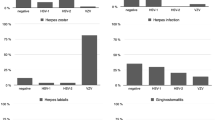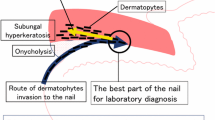Summary
Assessment of the efficacy of an antibiotic drug used in patients with various manifestations of dermatoborreliosis is crucial. Clinical judgement alone (resolution of the present dermatologic lesion, prevention of later major or minor sequelae) is not sufficient in erythema migrans and acrodermatitis chronica atrophicans. Thus, laboratory tests are desirable to prove the benefit of an antimicrobial agent. It was intended to establish a constant parameter — besides the clinical picture — for assessing the efficacy of antibiotic treatment in patients with dermatoborreliosis in terms of eradication ofBorrelia burgdorferi from the site of infection. Polymerase chain reaction (PCR) was therefore performed from pretreatment biopsy specimens from lesional skin of 36 erythema migrans patients (m:f=15:21, mean age 49 years) and seven acrodermatitis chronica atrophicans patients (m:f=0:7, mean age 59 years), respectively. After antibiotic therapy with minocycline (100 mg, orally twice daily, 14 days) for erythema migrans, and ceftriaxone (2 g, intravenously once daily, 14 days) for acrodermatitis chronica atrophicans another punch biopsy was obtained and analysed by PCR. In pretreatment specimens,B. burgdorferi-specific DNA was amplified by PCR in 23/36 erythema migrans patients (69%), and in 5/7 acrodermatitis chronica atrophicans patients (71%). After antibiotic therapy, PCR yielded negative results in all of these cases. Clinically, all patients showed complete recovery or at least marked improvement of lesions at this time. PCR appears to be a reliable parameter for the assessment of the efficacy of antibiotic treatment in dermatoborreliosis.
Zusammenfassung
Bei der Behandlung von Patienten mit Dermatoborreliose ist die Überprüfung der Wirksamkeit des eingesetzten Antibiotikums von entscheidender Bedeutung. Die klinische Beurteilung des Krankheitsverlaufes ist als Therapiekontrolle weder für Patienten mit Erythema migrans noch mit Acrodermatitis chronica atrophicans ausreichend. Es ist vielmehr notwendig, den klinischen Eindruck durch entsprechende Laborparameter abzusichern. In der vorliegenden Studie wurde daher nach einem zuverlässigen Parameter gesucht, welcher auf der Basis der Eradikation vonBorrelia burgdorferi in Zusammenschau mit dem klinischen Zustand des Patienten, festzustellen vermag, ob ein Antibiotikum erfolgreich war oder nicht. Es wurde daher vor Therapiebeginn eine Polymerase-Ketten-Reaktion (PCR) von Gewebeproben läsioneller Haut bei 36 Patienten mit Erythema migrans (15 Männer, 21 Frauen, Durchschnittsalter 49 Jahre) und sieben Patienten mit Acrodermatitis chronica atrophicans (sieben Frauen, Durchschnittsalter 59 Jahre) durchgeführt. Die Patienten mit Erythema migrans wurden danach mit Minocyclin (100 mg 2x täglich, peroral, 14 Tage) und die Patienten mit Acrodermatitis chronica atrophicans mit Ceftriaxon (2 g 1x täglich, intravenös, 14 Tage) behandelt. Nach der Therapie wurde erneut eine Stanzbiopsie aus der Haut entnommen und mittels PCR analysiert. Während vor TherapiebeginnB. burgdorferi-spezifische DNA bei 23/36 Patienten mit Erythema migrans (69%) und bei 5/7 Patienten mit Acrodermatitis chronica atrophicans (71%) amplifiziert werden konnte, wurde nach der Behandlung bei keinem einzigen PatientenB. burgdorferi-spezifische DNA in der Gewebeprobe nachgewiesen. Klinisch war zu diesem Zeitpunkt Abheilung oder klare Besserung des Hautzustandsbildes bei allen Patienten gegeben. Die PCR scheint ein zuverlässiger Parameter für die Kontrolle antibiotischer Therapie der Dermatoborreliose zu sein.
Similar content being viewed by others
References
Weber, K., Neubert, U. Clinical features of early erythema migrans disease and related disorders. Zbl. Bakt. Hyg. A 263 (1986) 209–228.
Asbrink, E., Olsson, I., Hovmark, A. Erythema chronicum migrans Afzelius in Sweden. A study on 231 patients. Zbl. Bakt. Hyg. A 263 (1986) 229–236.
Weber, K. Therapy of cutaneous manifestations. In:Weber, K., Burgdorfer, W. (eds.): Aspects of Lyme borreliosis. Springer Verlag, Berlin-Heidelberg 1993, pp. 312–327.
Weber, K., Pfister, H. W. Clinical management of Lyme borreliosis. Lancet 343 (1994) 1017–1020.
Weber, K., Preac Mursic, V., Neubert, U., Thurmayr, R., Herzer, P., Wilske, B., Schierz, G., Marget, W. Antibiotic therapy of early European Lyme borreliosis and acrodermatitis chronica atrophicans. Ann. NY Acad. Sci. 539 (1988) 324–345.
Weber, K., Neubert, U., Thurmayr, R. Antibiotic therapy in early erythema migrans disease and related disorders. Zbl. Bakt. Hyg. A 263 (1986) 377–388.
Preac-Mursic, V., Weber, K., Pfister, H. W., Wilske, B., Gross, B., Baumann, A., Prokop, J. Survival ofBorrelia burgdorferi in antibiotically treated patients with Lyme borreliosis. Infection 17 (1989) 355–359.
Weber, K., Preac Mursic, V., Wilske, B., Thurmayr, R., Neubert, U., Scherwitz, C. A randomized trial of ceftriaxone versus oral penicillin for the treatment of early European Lyme borreliosis. Infection 18 (1990) 91–96.
Weber, K., Wilske, B., Preac Mursic, V., Thurmayr, R. Azithromycin versus penicillin V for the treatment of early Lyme borreliosis. Infection 21 (1993) 361–372.
Kuiper, H., van-Dam, A. P., Spanjaard, L., de-Jongh, B. M., Widjojokusumo, A., Ramselaar, T. C., Cairo, I., Vos, K., Dankert, J. Isolation ofBorrelia burgdorferi from biopsy specimens taken from healthy-looking skin of patients with Lyme borreliosis. J. Clin. Microbiol. 32 (1994) 715–720.
Melchers, W., Meis, J., Rosa, P., Claas, E., Nohlmans, L., Koopman, R., Horrevorts, A., Galama, J. Amplification ofBorrelia burgdorferi DNA in skin biopsies from patients with Lyme disease. J. Clin. Microbiol. 29 (1991) 2401–2406.
Schwartz, I., Wormser, G., Schwartz, J. J., Cooper, D., Weissensee, P., Gazumyan, A., Zimmermann, E., Goldberg, N. S., Bittker, S., Campbell, G. L., Pavia, C. S. Diagnosis of early Lyme disease by polymerase chain reaction amplification and culture of skin biopsies from erythema migrans lesions. J. Clin. Microbiol. 30 (1992) 3082–3088.
Weber, K., Thurmayr, R. Oral pencillin versus minocycline for the treatment of early Lyme borreliosis. Zbl. Bakt. Hyg. A Suppl. 18 (1989) 263–268.
Muellegger, R. R., Zoechling, N., Soyer, H. P., Hoedl, S., Wienecke, R., Volkenandt, M., Kerl, H. No detection ofBorrelia burgdorferi-specific DNA in erythema migrans lesions after minocycline treatment. Arch. Dermatol. 131 (1995) 678–682.
Hassler, D., Zoeller, L., Haude, M., Hufnagel, H. D., Heinrich, F., Sonntag, H. G. Cefotaxime versus penicillin in the late stage of Lyme disease — prospective, randomized therapeutic study. Infection 18 (1990) 16–20.
Wienecke, R., Neubert, U., Volkenandt, M. Molecular detection ofBorrelia burgdorferi in formalin-fixed, paraffin-embedded lesions of Lyme disease. J. Cutan. Pathol. 20 (1993) 385–388.
Hansen, K., Asbrink, E. Serodiagnosis of erythema migrans and acrodermatitis chronica atrophicans by theBorrelia burgdorferi flagellum enzyme-linked immunosorbent assay. J. Clin. Microbiol. 27 (1989) 545–551.
Dattwyler, R. J., Volkman, D. J., Luft, B. J., Halperin, J. J., Thomas, B. S., Golightly, M. G. Seronegative Lyme disease: dissociation of specific T- and B-lymphocyte responses toBorrelia burgdorferi. N. Engl. J. Med. 319 (1988) 1441–1446.
Steere, A. C., Hutchinson, G. J., Rahn, D. W., Sigal, L. H., Craft, J. E., Desanna, E. T., Malawista, S. E. Treatment of the early manifestations of Lyme disease. Ann. Intern. Med. 99 (1983) 22–26.
Asbrink, E., Hovmark, A. Early and late cutaneous manifestations inIxodes-borne borreliosis (erythema migrans borreliosis, Lyme borreliosis). Ann. NY Acad.Sci. 539 (1988) 4–15.
Langer, K., Diem, E. Acrodermatitis chronica atrophicans und sklerodermiforme Hautveränderungen beiBorrelia-Infektion. Hautarzt 39 (1988) 647–651.
Steere, A. C. Lyme disease. N. Engl. J. Med. 321 (1989) 586–596.
Johnson, R. C.: Lyme disease — past, present and future. In:Cevenini, R., Sambri, V., La Placa, M. (eds.): Advances in Lyme borreliosis research. Proceedings of the VIth International Conference on Lyme borreliosis. Bologna, Italy, June 19–22, 1994, pp. 1–6.
Author information
Authors and Affiliations
Rights and permissions
About this article
Cite this article
Muellegger, R.R., Zoechling, N., Soyer, H.P. et al. Polymerase chain reaction control of antibiotic treatment in dermatoborreliosis. Infection 24, 76–79 (1996). https://doi.org/10.1007/BF01780664
Issue Date:
DOI: https://doi.org/10.1007/BF01780664




